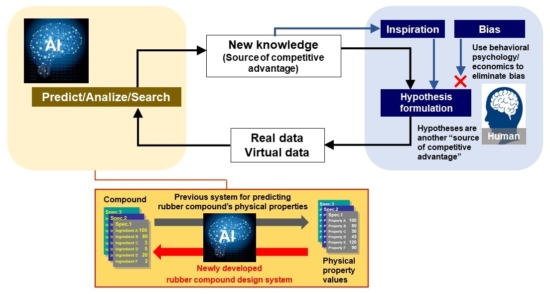AI compounding: Yokohama Rubber introduces latest technology
 Image: Yokohama Rubber
Image: Yokohama Rubber
Yokohama Rubber hopes to speed up its tyre development process by implementing new rubber compounding technology that draws upon the power of artificial intelligence (AI). It is turning to a process that utilises AI-based compound generation technology to achieve user-set target property values. Yokohama explains that this AI-driven technology “enables the acquisition of new knowledge about compounds that humans could not have conceived independently.”
Developed together with information system development subsidiary Hamagomu Aicom, this new technology is the latest development from Yokohama Rubber to draw upon the HAICoLab (Humans and AI ColLaborate) AI utilisation concept. When employed to predict the physical properties of rubber compounds, the previous generation HAICoLab technology based its AI-generated compound property value predictions upon user-entered compound design parameters. The new system takes the process one step further by having AI generate candidate compounds based on specific desired compound property values. The system then proposes compounds that satisfy the target physical property values.
HAICoLab’s AI has learned tens of thousands of rubber compounds and can generate candidate compounds that combine more than 100 types of compounding agents. The system then compares the predicted physical property values of multiple candidate compounds with the targeted physical property values and draws the user’s attention to those compounds meeting the targeted values. In addition to specifying the basic compound and compounding agents to be used, the new system also allows users to search for data that is close to the specific selected compound.
Human-AI collaboration
Yokohama Rubber established HAICoLab in 2020 to foster digital innovation by “facilitating collaborative efforts that merge human inspiration and creativity with the enormous data processing capability of AI.” The company aims to acquire new knowledge by creating and collecting data based upon user-determined hypothetical conditions and then applying AI to predict, analyse and then search for the most optimal result.
Since establishing the HAICoLab concept, Yokohama Rubber has used the AI technology to achieve a number of technological breakthroughs. For example, in 2020 it developed a system that utilises AI to predict the physical properties of rubber compounds used in its tyres, and last year began using a system it developed to predict the values of specific tyre characteristics.

 Banner
Banner

Comments